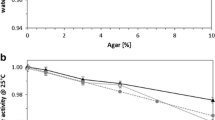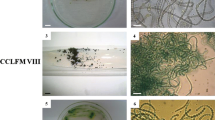Abstract
Paenarthrobacter aurescens strain TC1 can use the herbicide atrazine and its degradation product isopropylamine as nutrients. Because osmotic stress can change the morphology of arthrobacters and decrease their metabolism of some carbon compounds, the effects of increasing NaCl concentrations on strain TC1 and its ability to utilize atrazine and isopropylamine were determined. Strain TC1 was cultured in minimal media with different NaCl concentrations and varying combinations of d-glucose, ammonium sulfate, atrazine, or isopropylamine. Growth was measured quantitatively as an increase in turbidity. Physiological effects were assessed using Biolog™ GP test plates and BD BBL Crystal GP or bioMérieux API 20E test systems. The effects of osmoprotective compounds were determined in liquid media and on agar plates. Strain TC1 formed multicellular myceloids and its growth rate slowed as the salt concentration increased, but the culture yields were similar up to 0.6 mol l−1 NaCl. The bacteria metabolized about half the carbon sources in Biolog™ GP test plates, but their use of some compounds and several hydrolytic activities decreased with high salt concentrations. However, strain TC1 grew well with atrazine and isopropylamine as the nitrogen source in media containing up to 0.6 mol l−1 NaCl. Growth in 0.8 mol l−1 NaCl was more limited but could be enhanced by glycine betaine, L-proline, and L-glutamate. P. aurescens strain TC1 can continue to use atrazine and isopropylamine as nutrients during osmotic stress and so may be particularly useful for remediation of contaminated soils with low water activity.




Similar content being viewed by others
References
Anon., American Type Culture Collection, Manassas, VA, USA (2016) https://www.atcc.org/~/media/A4CF742B46514D579AAEB111AA55E7F9.ashx. Accessed 25 Aug 2016
Assaf NA, Turco RF (1994) Influence of carbon and nitrogen application on the mineralization of atrazine and its metabolites in soil. Pestic Sci 41:41–47
Bastos AC, Magan N (2009) Trametes versicolor: potential for atrazine bioremediation in calcareous clay soil, under low water availability conditions. Int Biodeterior Biodegradation 63:389–394
Bochner BR (1989) Sleuthing out bacterial identifies. Nature 339:157–128
Bochner BR, Savageau MA (1977) Generalized indicator plate for genetic, metabolic, and taxonomic studies with microorganisms. Appl Environ Microbiol 33:434–444
Boffetta P, Adami HO, Berry SC, Mandel JS (2013) Atrazine and cancer: a review of the epidemiological evidence. Eur J Cancer Prevent 22:169–180
Brown AD (1976) Microbial water stress. Bacteriol Rev 40:803–846
Busse HJ (2016) Review of the taxonomy of the genus Arthrobacter, emendation of the genus Arthrobacter sensu lato, proposal to reclassify selected species of the genus Arthrobacter in the novel genera Glutamicibacter gen. nov., Paeniglutamicibacter gen. Nov., Pseudoglutamibacter gen. nov., Paenarthrobacter gen. nov., and Pseudarthrobacter gen. nov. and emended description of Arthrobacter roseus. Int J System Evol Microbiol 66:9–37
Časaitė V, Bružytė S, Meškys R (2006) Effect of glycine betaine on osmoadaptation of Arthrobacter strains. Biologija 4:46–48
Časaitė V, Povilonienė S, Mešklenė R, Rutkienė R, Meškys R (2011) Studies of dimethylglycine oxidase isoenzymes in Arthrobacter globiformis cells. Curr Microbiol 62:1267–1273
Chan ECS, Zyk B, Gomersall M (1973) Biotin deficiency in Arthrobacter globiformis: comparative cell ultrastructure and nonreplacement of the compound by structurally unrelated compounds. J Bacteriol 113:394–402
de Azevedo Wäsch SI, van der Ploeg JR, Maire T, Lebreton A, Kiener A, Leisinger T (2002) Transformation of isopropylamine to L-alaninol by Pseudomonas sp. strain KIE171 involves N-glutamylated intermediates. Appl Environ Microbiol 68:2368–2374
De Souza ML, Newcombe D, Alvey S, Crowley DE, Hay A, Sadowsky MJ, Wackett LP (1998) Molecular basis of a bacterial consortium: interspecies catabolism of atrazine. Appl Environ Microbiol 64:178–184
Deutch CE, Perera GS (1992) Myceloid cell formation in Arthrobacter globiformis during osmotic stress. J Appl Bacteriol 72:493–499
Fan X, Song F (2014) Bioremediation of atrazine: recent advances and promises. J Soils Sediments 14:1727–1737
Galinski EA (1995) Osmoadaptation in bacteria. Adv Microbial Physiol 37:273–328
Gebendinger N, Radosevich M (1999) Inhibition of atrazine degradation by cyanazine and exogenous nitrogen in bacterial isolate M91-3. Appl Microbiol Biotechnol 51:375–381
Germida JJ, Casida LE Jr (1980) Myceloid growth of Arthrobacter globiformis and other Arthrobacter species. J Bacteriol 144:1152–1158
Goodman M, Mandel JS, DeSesso JM, Scialli AR (2014) Atrazine and pregnancy outcomes: a systematic review of epidemiological evidence. Birth Defects Res B Dev Reprod Toxicol 101:215–236
Hayes TB, Anderson LL, Beasley VR, de Solla SR, Iguchi T, Ingraham H, Kestemont P, Kniewald J, Kniewald Z, Langlois VS, Luque EH, McCoy KA, Muñoz-de-Toro M, Oka T, Oliveira CA, Orton F, Ruby S, Suzawa M, Tavera-Mendoza LE, Trudeau VL, Victor-Costa AB, Willingham E (2011) Demasculinization and feminization of male gonads by atrazine: consistent effects across vertebrate classes. J Steroid Biochem Mol Biol 127:64–73
Issa S, Wood M (2005) Degradation of atrazine and isoproturon in surface and sub-surface soil materials undergoing different moisture and aeration conditions. Pest Manag Sci 61:126–132
Jablonowski ND, Schäffer A, Burauel P (2011) Still present after all these years: persistence plus potential toxicity raise questions about the use of atrazine. Environ Sci Pollut Res 18:328–331
Kempf B, Bremer E (1998) Uptake and synthesis of compatible solutes as microbial stress responses to high-osmolality environments. Arch Microbiol 170:319–330
Malwane S, Deutch CE (1999) Adaptive characteristics of salt-induced myceloids of Arthrobacter globiformis. Antonie Van Leeuwenhoek 75:335–344
Mongodin EF, Shapir N, Daugherty SC, DeBoy RT, Emerson JB, Shvartzbeyn A, Radune D, Vamathevan J, Riggs F, Grinberg V, Khouri H, Wackett LP, Nelson KE, Sadowsky MJ (2006) Secrets of soil survival revealed by the genome sequence of Arthrobacter aurescens TC1. PLoS Genet 2:2094–2105
Moreno JL, Aliaga A, Navarro S, Hernández T, García C (2007) Effects of atrazine on microbial activity in semiarid soil. Appl Soil Ecol 35:120–127
Morris JG (1960) Studies on the metabolism of Arthrobacter globiformis. J Gen Microbiol 22:564–582
Nousiainen AO, Björklöf K, Sagarkar S, Nielsen JL, Kapley A, Jorgensen KS (2015) Bioremediation strategies for removal of residual atrazine in the boreal groundwater zone. Appl Microbiol Biotechnol 99:10249–10259
Ralebitso TK, Senior E, van Verseveld HW (2002) Microbial aspects of atrazine degradation in natural environments. Biodegradation 13:11–19
Rice PJ, Anderson TA, Coats JR (2002) Degradation and persistence of metolachlor in soil: effects of concentration, soil moisture, soil depth, and sterilization. Environ Toxicol Chem 21:2640–2648
Satsuma K (2009) Complete biodegradation of atrazine by a microbial community from a naturally derived river ecosystem (microcosm). Chemosphere 77:590–596
Schroll R, Becher HH, Dörfler U, Gayler S, Grundmann S, Hartmann HP, Ruoss J (2006) Quantifying the effect of soil moisture on the aerobic microbial mineralization of selected pesticides in different soils. Environ Sci Technol 40:3305–3312
Seffernick JL, Aleem A, Osborne JP, Johnson G, Sadowsky MJ, Wackett LP (2007) Hydroxyatrazine N-ethylaminohydrolase (AtzB): an amidohydrolase superfamily enzyme catalyzing deamination and dichlorination. J Bacteriol 189:6989–6997
Sereno AM, Hubinger MD, Comesaña JF, Correa A (2001) Prediction of water activity of osmotic solutions. J Food Eng 49:103–114
Shapir N, Mandelbaum RT, Gottlieb H (1998) Atrazine degradation in saline seawater by Pseudomonas sp. strain ADP. J Ind Microbiol Biotechnol 20:153–159
Shapir N, Osborne JP, Johnson G, Sadowsky MJ, Wackett LP (2002) Purification, substrate range, and metal center of AtzC: the N-isoprolyammelide aminohydrolase involved in bacterial atrazine metabolism. J Bacteriol 184:5376–5384
Shapir N, Rosendahl C, Johnson G, Andreina M, Sadowsky MJ, Wackett LP (2005) Substrate specificity and colorimetric assay for recombinant TrzN derived from Arthrobacter aurescens TC1. Appl Environ Microbiol 71:2214–2220
Shapir N, Mongodin EF, Sadowsky MJ, Daugherty SC, Nelson KE, Wackett LP (2007) Evolution of catabolic pathways: genomic insights into microbial s-triazine metabolism. J Bacteriol 189:674–682
Singh B, Singh K (2016) Microbial degradation of herbicides. Crit Rev Microbiol 42:245–261
Strong LC, Rosendahl C, Johnson G, Sadowsky MJ, Wackett LP (2002) Arthrobacter aurescens TC1 metabolizes diverse s-triazine ring compounds. Appl Environ Microbiol 68:5973–5980
Su W, Hao H, Wu R, Xu H, Xue F, Lu C (2017) Degradation of mesotrione affected by environmental conditions. Bull Environ Contam Toxicol 98:212–217
Van Der Kraak GJ, Hosmer AJ, Hanson ML, Kloas W, Solomon KR (2014) Effects of atrazine in fish, amphibians, and reptiles: an analysis based on quantitative weight of evidence. Crit Rev Toxicol 44(suppl 5):1–66
Vibber LL, Pressler MJ, Colores GM (2007) Isolation and characterization of novel atrazine-degrading microorganisms from an agricultural soil. Appl Microbiol Biotechnol 75:921–928
Vyrides I, Stuckey DC (2017) Compatible solute addition to biological systems treating waste/wastewater to counteract osmotic and other environmental stresses: a review. Crit Rev Biotechnol 37:865–879
Wackett LP, Sadowsky MJ, Martinez B, Shapir N (2002) Biodegradation of atrazine and related s-triazine compounds: from enzymes to field studies. Appl Microbiol Biotechnol 58:39–45
Wang H, Liu Y, Lin M, Hu X (2016) Biodegradation of atrazine by Arthrobacter sp. C3, isolated from the herbicide-contaminated corn field. Int J Environ Sci Technol 13:257–262
Weber JB (1993) Ionization and sorption of fomesafen and atrazine by soils and soil constituents. Pestic Sci 39:31–38
Wildman H (2016) Importance of water activity to soil microorganisms Poster available at https://www.researchgate.net/publication/305617763_Importance_of_water_activity_to_soil_microorganisms https://doi.org/10.13140/RG.2.1.3754.3924
Wood JM (2011) Bacterial osmoregulation: a paradigm for the study of cellular homeostasis. Annu Rev Microbiol 65:215–238
Wood JM, Bremer E, Csonka LN, Kraemer R, Poolman B, van der Heide T, Smith LT (2001) Osmosensing and osmoregulatory compatible solute accumulation by bacteria. Comp Biochem Physiol Part A 130:437–460
Ye JY, Zhang JB, Gao JG, Li HT, Liang D, Liu RM (2016) Isolation and characterization of atrazine-degrading strain Shewanella sp. YJY4 from cornfield soil. Lett Appl Microbiol 63:45–52
Zevenhuizen LP (1992) Levels of trehalose and glycogen in Arthrobacter globiformis under conditions of nutrient starvation and osmotic stress. Antonie Van Leeuwenhoek 61:61–68
Zhang Y, Jiang Z, Cao B, Hu M, Wang DX (2011) Metabolic ability and gene characteristics of Arthrobacter sp. strain DNS10, the sole atrazine-degrading strain in a consortium isolated from black soil. Int Biodeterior Biodegradation 65:1140–1144
Zhang Y, Cao B, Jiang Z, Dong X, Hu M, Wang Z (2012) Metabolic ability and individual characteristics of an atrazine-degrading consortium DNC5. J Hazard Materials 237-238:376–381
Zhang Q, Zhu L, Su J, Wang J, Xie H, Wang J, Wang F (2014) Impacts of nitrogen and phosphorus on atrazine-contaminated soil remediation and detoxification by Arthrobacter sp. strain HB-5. Environ Earth Sci 71:1465–1471
Acknowledgements
We thank Dr. Michael Sadowsky of the University of Minnesota for the culture of P. aurescens TC1 and the Syngenta Corporation for the sample of atrazine used in these studies. Disclaimer: some of these experiments were done off campus and Arizona State University has no liability for that work.
Author information
Authors and Affiliations
Corresponding author
Ethics declarations
Conflicts of interest
The authors declare that they have no conflict of interest.
Human or animal participants
No humans or animals were used in this project.
Rights and permissions
About this article
Cite this article
Deutch, C.E., Bui, A.P. & Ho, T. Growth of Paenarthrobacter aurescens strain TC1 on atrazine and isopropylamine during osmotic stress. Ann Microbiol 68, 569–577 (2018). https://doi.org/10.1007/s13213-018-1364-9
Received:
Accepted:
Published:
Issue Date:
DOI: https://doi.org/10.1007/s13213-018-1364-9




